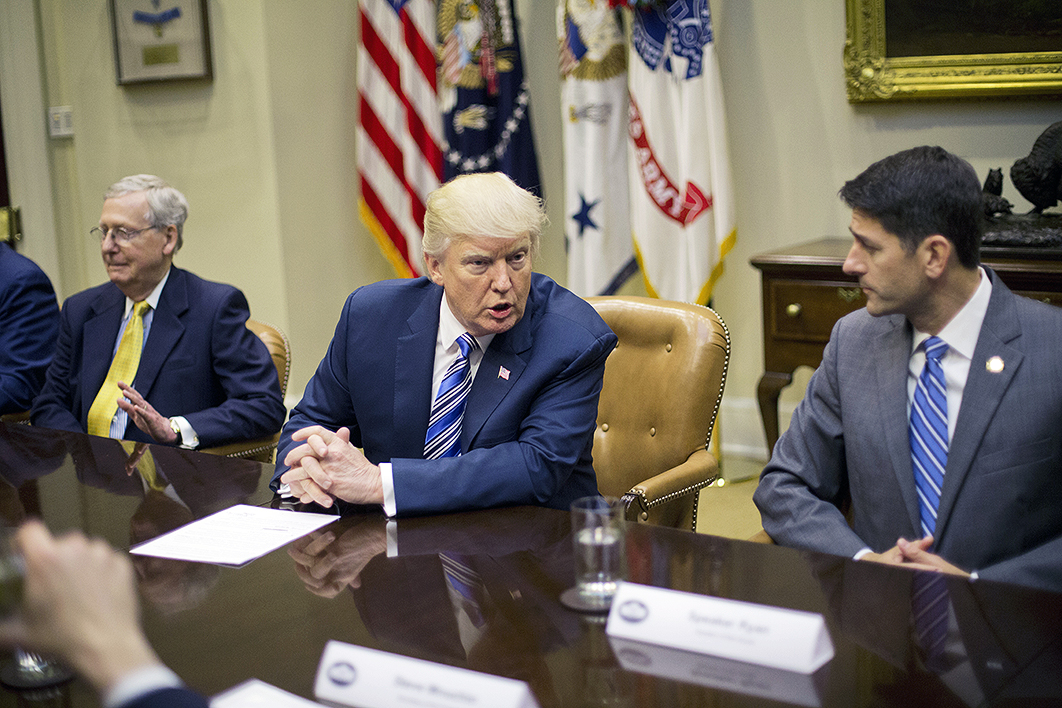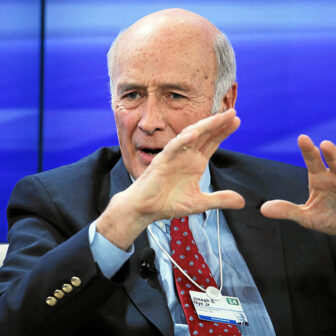In a report released last month Donald Trump’s Council of Economic Advisers declared that the War on Poverty, introduced by president Lyndon Johnson in 1964, is “largely over” and has been “a success.” It denied that homelessness is a “meaningful problem,” declared that “reduced diet quality as a consequence of limited resources” isn’t really hunger, and stated, in the face of problems in cities like Flint, Michigan, that “almost all Americans have access to clean water.”
The report might be “page after page of gaslighting the very real hardships faced by tens of millions of Americans,” as one expert on poverty described it, but it also represents a complete reversal by the Republicans. For years they have proclaimed the War on Poverty to be a failure. It has been “a stalemate at best,” declared House speaker Paul Ryan in 2016, reprising a long-held position at the launch of his own plan to dramatically scale back the welfare safety net. Yet Republicans now say the War on Poverty has worked so well it is no longer needed.
That’s where last month’s report comes in. Its main role is signalled in its title, Expanding Work Requirements in Non-Cash Welfare Programs, and the headline above the accompanying summary, “Poverty Has Declined in the United States, and Work Requirements in Welfare Programs Are Not a Punishment.” It is intended to support the push by President Trump and Republican congressional leaders to impose or step up work requirements for Americans who receive benefits from federal safety net programs. With control of Congress and the White House, Republicans see this as a once-in-a-generation opportunity to overhaul programs they have long argued are wasteful, easily exploited and encouraging of dependency.
Not necessarily coincidentally, the United States is engaged in a war of words and data with the United Nations. This began in December last year with a very blunt statement from Philip Alston, the Australian lawyer who is the UN special rapporteur on extreme poverty and human rights, following a visit to the United States at government invitation. “American exceptionalism was a constant theme in my conversations,” he said. “But instead of realising its founders’ admirable commitments, today’s United States has proved itself to be exceptional in far more problematic ways that are shockingly at odds with its immense wealth and its founding commitment to human rights.”
Six months later, Alston’s formal report on the state of poverty in the United States singled out Trump’s policies for criticism. “The policies pursued over the past year,” it said, “seem deliberately designed to remove basic protections from the poorest, punish those who are not in employment and make even basic health care into a privilege to be earned rather than a right of citizenship.” It seems likely that a secondary aim of the Council of Economic Advisers report was a rebuttal of Alston’s work.
Using 2016 census data, Alston found that 12.7 per cent of the population, some forty-three million Americans, live in poverty (defined in 2016 as US$12,486 per year for a single individual under sixty-five and US$24,339 for a family of four with two children under eighteen). Around 18.5 million of them live in extreme poverty (that is, an annual income less than 50 per cent of the poverty level) and 5.3 million live in “third world conditions of absolute poverty,” defined as less than $4 a day. Children comprised 32.6 per cent of all people in poverty.
The US representative at the United Nations and other international organisations, Nikki Haley, objected strongly to Alston’s findings, calling them “misleading and politically motivated.” The Trump administration’s report claims that only 3 per cent of the population is in poverty and no more than 250,000 Americans are in “extreme poverty.”
How is it possible to reach such different conclusions? The problem starts with definitions of poverty and how these are used. The federal government’s official poverty measure, which determines access to welfare programs, is calculated annually by taking the census bureau’s poverty thresholds and adjusting them using the consumer price index. This year, the figure is US$12,140 for a single person and US$25,100 for a family of four. Those who live in households with earnings below those incomes are considered to be in poverty.
The other yardstick, the supplemental poverty measure, includes an estimate of real household expenditures, as well as income from all sources, including government programs, and yields higher thresholds. It isn’t used to determine eligibility for government programs, though many argue it should be. In 2016 the supplemental poverty measure was 14 per cent, 1.3 percentage points higher than the official poverty rate of 12.7 per cent. Research has shown that poverty measured in this way has fallen since 1965, but entirely because of government programs.
Some conservatives claim that America’s real poverty rate is close to zero. “Our poverty program has actually been enormously successful if you measure it in the appropriate way,” declared a Cornell University economist who was a member of the Council of Economic Advisers. “It’s time to acknowledge we succeeded.”
Meanwhile, the Stanford Center on Poverty and Inequality ranks the United States last of the top ten most well-off countries in terms of labour markets, poverty, safety nets, wealth inequality and economic mobility, and says that the country is “a clear and constant outlier in the child poverty league.”
Armed with the Council of Economic Advisers report, Donald Trump and the Republican leaders in Congress have set about adding or stepping up work requirements in three programs: Medicaid (which currently provides healthcare cover to sixty-eight million people, including fifteen million with disabilities); the Supplemental Nutrition Assistance Program (better known as food stamps, which provides food and nutrition to forty-five million); and several federal housing assistance programs that currently assist 4.5 million households.
In January, the administration issued a guidance to the states to allow them to withhold Medicaid from recipients unless they have a job, are in school, are a caregiver or volunteer, or participate in other approved forms of community engagement. In April, Trump signed an executive order instructing his cabinet to find other social services for which they could impose work requirements or make existing requirements harsher. In June, House Republicans passed a farm bill that imposed harsher work requirements for recipients of food stamps; these changes were stripped out by the Senate, leaving the bill hostage to Paul Ryan’s demands for more stringent work requirements.
Realistically, none of these efforts is going anywhere fast. Aside from Congress’s failure to enact legislation, the states’ attempts to impose workforce requirements have been stymied since late June, when the Trump administration lost the first court test of work requirements.
In a seminal case with widespread ramifications, a US District Court judge struck down the Department of Health and Human Services’s approval of Kentucky’s request to impose work requirements on Medicaid recipients. The judge found that the approval failed to demonstrate that a work requirement was consistent with the purpose of the Medicaid program — to furnish medical assistance — and that this rendered the approval “arbitrary and capricious.” “While plaintiffs and their amici assert that these proclaimed health benefits are unsupported by substantial evidence, the Court need not enter that thicket,” the judge went on. The department’s case failed for a more basic reason: “it is little more than sleight of hand.”
Such a judgement sends a strong message. If the federal or state governments want to implement work requirements, they face a very high bar in arguing the connection to health.
It’s worth noting that Kentucky (represented in the US Senate by Senate leader Mitch McConnell and Rand Paul, both fierce opponents of Obamacare) had very successfully implemented an expansion of Medicaid under Obamacare in 2014, making 500,000 additional low-income people eligible for benefits. An evaluation showed that the cost to the state budget was more than offset by revenue generated by extra economic activity, giving a net gain of nearly US$820 million to state and local governments through to 2021. Yet the current governor, a Tea Party Republican elected in 2015, has opposed the expansion. Miffed at his inability to implement work requirements, he has ended dental and vision benefits for Medicaid expansion recipients.
Trump administration officials remain committed to work requirements because they believe the measures not only reduce reliance on government programs but also improve a person’s physical and mental health. But there is little evidence of health improvements after welfare-to-work transitions, and the statistics show that many people who leave welfare, especially women, remain poor.
Welfare advocates agree that encouraging people to work is a good thing, But they argue that imposing strict requirements on already vulnerable populations, particularly coupled with an aggressive effort to slash funding and shrink public assistance programs, could be disastrous for those in need. The consequences could be especially dire for those already having trouble finding and keeping a job, including single mothers who can’t afford childcare, people who lack access to transport, and those suffering from mental illness.
In reality, the majority of people receiving federal welfare benefits who can work, do work. Using data from 2013 (before the expansion of Medicaid under the Affordable Care Act), the Council of Economic Advisers report found that more than half of the working-age, non-disabled beneficiaries of Medicaid, federal housing support or food stamps worked fewer than twenty hours a week. The report failed to consider whether beneficiaries had the capacity to work extended hours, despite the fact that most of the people of working age who were enrolled in Medicaid in 2013 were pregnant women or the poor parents of very young children. Kaiser Family Foundation data from 2017, after Medicaid’s expansion, found that 60 per cent of Medicaid enrolees had full- or part-time jobs.
Trump and his supporters’ belief that welfare programs primarily benefit racial minorities is not accurate: the number of white Americans who benefit from Medicaid (43 per cent) is almost equal to the combined total of African Americans (18 per cent) and Hispanics (30 per cent), and the figures are similar for food stamps. Of families getting help from the Temporary Assistance for Needy Families program, 30 per cent are black, 37 per cent Hispanic and 28 per cent white. No one seems to remember that Ronald Reagan’s infamous “welfare queen,” who engaged in major fraud, was white.
In Trump’s world, intentions are as good as actions and ideology overrides evidence. His continuing demonisation of the “undeserving poor,” often using dog whistles and racist terms, plays to his base, many of whom are struggling economically. His rhetoric amplifies the “us versus them” divisions and signals to his resentful white supporters that they are the real victims and that he will protect them against those who threaten their livelihoods and way of life.
UN rapporteur Alston summed it up: “I have been struck by the extent to which caricatured narratives about the purported innate differences between rich and poor have been sold to the electorate by some politicians and media, and have been allowed to define the debate. The rich are industrious, entrepreneurial, patriotic, and the drivers of economic success. The poor are wasters, losers, and scammers. As a result, money spent on welfare is money down the drain. To complete the picture we are also told that the poor who want to make it in America can easily do so: they really can achieve the American dream if only they work hard enough.”
The underlying racist leanings of the attack on welfare are demonstrated by how states plan to impose work requirements. Proposals from red states like Kentucky, Michigan and Ohio all include exemptions for the counties with the highest unemployment, which tend to be rural, majority-white, and GOP-leaning. The result would be a disproportionate impact on African Americans and Hispanics in urban areas.
It is no surprise, given the current political climate, that the attack on welfare is being extended to include immigrants. The Trump administration is advancing a plan to punish legal immigrants for accepting the food stamps, public housing, Medicaid and other government benefits to which they are entitled. This is designed to appeal to Trump supporters and to help galvanise Republican voters before the midterm elections.
But this strategy could well run foul of Title VI of the Civil Rights Act, which prohibits race-based discrimination in federal assistance programs. Under the statute, even policies that are racially neutral on the face of it, but have a heavier impact on a particular group, could be illegal.
Alston’s report highlighted the human rights dimensions of these policies. “The United States is alone among developed countries,” it said, “in insisting that, while human rights are of fundamental importance, they do not include rights that guard against dying of hunger, dying from a lack of access to affordable health care or growing up in a context of total deprivation.”
Venturing into another highly charged area, the report also noted that people living in poverty and minorities are being systematically deprived of their right to vote by gerrymandered electoral districts, artificial and unnecessary voter identification requirements, obstacles to obtaining such identification, manipulated polling station locations, and a general ramping up of obstacles to voting, especially for those without resources.
These problems didn’t start with Donald Trump, but they have been magnified under his presidency, and his prejudices have played into the hands of the increasingly conservative Republican law-makers in Congress. Their rhetoric obscures the fact that most of the increased benefits of a strong economy and tax cuts have gone to higher-income earners and that, despite low unemployment, many people remain trapped in volatile jobs and have limited savings. And for people born into poverty, getting out takes time: in the United States it is estimated to take five generations.
The upcoming midterm elections will be decisive for many reasons, not least for the future of America’s poor and the welfare programs they rely on. Helping them to clear the hurdles and get out to vote will be important. International evidence shows that bolstering turnout leads to an increased political focus on welfare expansion and greater resource redistribution, one way of addressing rising inequality. •




